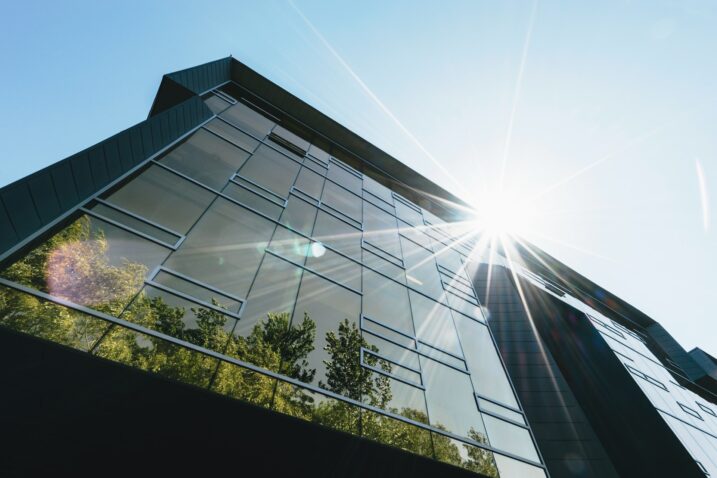Saubere Luft ist ein wertvolles Gut

Inhaltsverzeichnis
The UK economy is suffering at the hands of Coronavirus. To recover from the protracted lockdown, we must embark upon large-scale reopening of business.
It’s widely accepted that personal contact and face-to-face brainstorming stimulate innovation and change, as well as championing corporate culture. Most companies, therefore, want their staff to come back into the fold, at least on a part time basis, so that their bricks-and-mortar tangible assets can again add value to the bottom line.
Der Widerstand wächst
But workers are resisting companies‘ attempts to lure them back into the office and, in the USA, it’s even suggested that some employees will kündigen würden, anstatt die Heimarbeit aufzugeben. That may be a stretch, but for many who do want to come back, albeit with a balance between office and home working, reassurance is critical. Just as people expect pure water from the tap, hygienic food from the shops, and sanitary office facilities, they also now expect saubere Luft at their place of work.
The anxiety is understandable, as the latest advice from the Weltgesundheitsorganisation (WHO) and Health & Safety Executive places far greater emphasis on COVID-19 transmission from inhaled airborne droplets, rather than from touching contaminated Oberflächen. If companies are to reap value from their office space, saubere Luft needs to be top of the facilities management agenda.
Simple air quality solution
Die Gewährleistung sauberer Luft kann Unternehmen Kopfzerbrechen bereiten. Die eigenen Unternehmensabläufe und das Gebäudemanagement in Zeiten der Pandemie und auch danach zu koordinieren, kann einige Schwierigkeiten mit sich bringen. Zum Glück gibt es eine einfache Lösung. It is relatively easy to measure air quality and determine if there’s a gap between existing workplace air quality and that recommended by the WHO and UK SAGE Committee.
Die WHO empfiehlt, dass ein Luftreiniger eingesetzt werden sollte, um die Lücke zwischen dem Mindestbedarf an Litern pro Person und Sekunde und der vorhandenen Lüftung zu schließen. Unternehmen können tragbare Luftreiniger einsetzen, ohne die Bausubstanz des Gebäudes zu beeinträchtigen. In Verbindung mit HLK-Systemen können diese problemlos die optimale kumulative Luftwechselrate pro Stunde erreichen.
Technologie matters
With many air purifier devices on the market, management may need more guidance. The SAGE-Ausschuss provides that in its November 2020 Bericht on air cleaning devices to combat SARS-CoV-2 transmission. Two technologies are recommended, Faserfilter (HEPA) and germicidal UV (UVC), which together trap and nachhaltig abzutöten. Coronavirus. SAGE also stresses the importance of independent laboratory testing to ensure efficacy and avoid any side effects, such as respiratory problems or skin irritation.
Further evidence of the efficacy of HEPA-Filtration und UVC-Licht is available from trusted sources. The diameter of the SARS-CoV-2 virus has been found to range between 50 nm to 140 nm, or 0.05 to 0.14 microns und Untersuchungen der NASA proves that HEPA-Filters are most efficient at capturing ultrafine particles below 0.3 microns in size, as well as larger particles. The larger sizes are arguably more important as the virus is carried in airborne aerosol droplets, over 10 microns in size, that protect it from evaporation.
Having trapped the virus, it must then be nachhaltig abzutöten.ed: a recent study by the Henry Ford Health System shows that UVC light is effective for killing COVID-19 on N95 respirators. Since the threshold for COVID-19 infection is estimated at only 300 virus particles, whereas an inhaled viral infection typically requires 1,950 to 3,000 virus particles, the case for air purification is even stronger.
Added value beyond Covid
Saubere Luft will play a vital role in bringing people back to the office. Es ist zwar schwer, den finanziellen Nutzen zu beziffern, der sich aus Zusammenarbeit vor Ort und Innovation ergibt, aber es gibt Studien, die belegen, dass saubere Luft zu weniger Fehlzeiten, besserer Gesundheit und höherer Produktivität führt.
In the USA, poor air quality is responsible for Höhe von 150 Milliarden costs per year. Of that, $93 billion represents lost productivity from headaches, fatigue, and irritation associated with sick building syndrome. The World Green Building Council: Berichts that, after cleaning the indoor air, employers have seen workplace productivity increase by up to 11%. Taking it up a level, a Harvard study showed that, with better air quality, cognitive scores were 61% higher across nine functional domains, including crisis response, strategy, and focused activity level.
Saubere Luft is undervalued. While it may not make the balance sheet, it should be part of the employer brand. ‘Goodwill‘ has long been acknowledged as an intangible asset, but it’s outward looking. In the current Covid climate, the health & Sicherheit of internal stakeholders counts more than ever. Their goodwill and return to the office hinge on it.
As published in Business Post, Juni 2021
Unverbindliches Angebot anfordern
Teilen Sie uns Ihre Bedürfnisse mit und erhalten Sie innerhalb von 24 Stunden ein Angebot.
Mit Experten sprechen
Buchen Sie ein kostenloses Beratungsgespräch mit einem unserer Experten.
